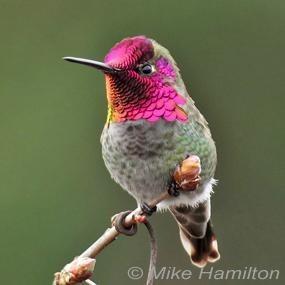BIRD OF THE MONTH: ANNA'S HUMMINGBIRD 
The mesmerizing Anna's Hummingbird is a medium-sized somewhat stocky hummingbird with a straight bill. It is metallic green above and grayish below. The male sports a rose-pink throat and crown that looks dark in indirect light. The female has rose-pink-red spotting on the throat, a tail edged in white scallops and a pale line over the eye. The Anna's Hummingbird is no larger than a ping pong ball and no heavier than a nickel.
The Anna's Hummingbird is common in urban and suburban settings as well as chaparral, coastal scrub, oak savannahs and open woodland. It eats nectar from many flowering plants including currant, gooseberry, manzanita and eucalyptus. It also eats a wide variety of insects including midges, whiteflies and leafhoppers as well as tiny spiders.
The female chooses the nest site and builds the nest usually in a tree or shrub. Once in a while one of the ladies will get creative and utilize a porch light, wind chime or other interesting location. The nest is made of plant down and spider webs and is typically one inch tall and one and a half inches in diameter. The outside is lovingly decorated with lichen or moss.
The female usually lays two white eggs the size of coffee beans. She then incubates the eggs for sixteen days and the chicks will fledge twenty days after hatching.
Often in late winter, early spring, people will wonder where their hummingbirds have gone as they are not seeing them at their feeders as often. The Anna's Hummingbird may have two to three broods a year and can nest anytime between December and June. Most typically they nest in February/March in our area and mom will rarely leave the nest while sitting on the eggs. She might venture out at dawn or just before sunset to grab a bite but is very diligent about keeping those eggs warm!
The Anna's Hummingbird is expert at hovering and zips from flower to flower. The male displays a wild courtship dive. He will fly as high as 130 feet into the air then plummet toward the ground as the female watches. A short, explosive, high-pitched squeak is made by the air whistling through his tail feathers before he arcs back up to the point where he began. On sunny days, he orients the dive so that the sun is reflected from his iridescent throat and crown.
As courtship progresses, the male follows a receptive female to her nesting site, perches, then performs a "shuttle display" where he swings back and forth about a foot above the female, keeping his body horizontal and his head down, often singing an intense song.
When not feeding or performing, the male often sits fairly high in a bush or small tree, noisily chattering. The male does not help with nest building or caring for the young.
Other cool facts:
A flock of hummingbirds is called a bouquet, a glittering, a hover, a shimmer or a tune.
The throat patch of male hummingbirds is called a gorget. Oddly, the female Anna's has a tiny gorget - females of most species have none.
The Anna's Hummingbird was named after Anna Messena who was a very prestigious woman in Europe. She lived from 1802 - 1887 and was married to the Duke of Rivoli.
Native Americans held hummingbirds in high esteem. Legends describe them as busily bringing rain to quench eruptions or poking holes in the night sky that became the stars. The Navajo say that the mating dive is a way for them to check what is above the blue of the sky.
The Anna's Hummingbird normally has a body temperature of around 107 degrees Fahrenheit. When outside temperatures fall, Anna's and many other species of hummingbirds enter torpor, a state in which breathing and heart rate are slowed and body temperature falls as low as 48 degrees. When the temperature warms up, the hummingbirds quickly become active again.
The oldest recorded Anna's Hummingbird was at least 8 years, 2 months old.
Attract Anna's Hummingbirds to your yard by offering a feeder filled with a mixture of four parts water and one part white granulated sugar. Do not use honey or food coloring. Anna's don't migrate so you can enjoy feeding them all year round!

